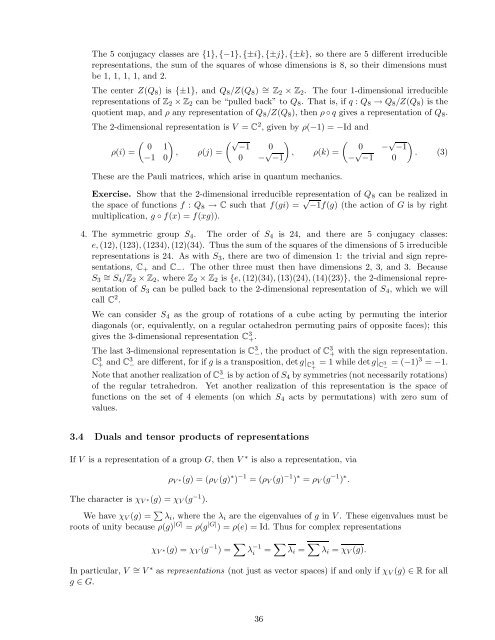Lecture notes for Introduction to Representation Theory
Lecture notes for Introduction to Representation Theory
Lecture notes for Introduction to Representation Theory
You also want an ePaper? Increase the reach of your titles
YUMPU automatically turns print PDFs into web optimized ePapers that Google loves.
The 5 conjugacy classes are {1}, {−1}, {±i}, {±j}, {±k}, so there are 5 different irreducible<br />
representations, the sum of the squares of whose dimensions is 8, so their dimensions must<br />
be 1, 1, 1, 1, and 2.<br />
The center Z(Q 8 ) is {±1}, and Q 8 /Z(Q 8 ) ∪ = Z 2 × Z 2 . The four 1-dimensional irreducible<br />
representations of Z 2 × Z 2 can be “pulled back” <strong>to</strong> Q 8 . That is, if q : Q 8 ⊃ Q 8 /Z(Q 8 ) is the<br />
quotient map, and δ any representation of Q 8 /Z(Q 8 ), then δ ∞ q gives a representation of Q 8 .<br />
The 2-dimensional representation is V = C 2 , given by δ(−1) = −Id and<br />
<br />
0 1 ∀ <br />
<br />
−1<br />
−1<br />
− ∀0 −1<br />
− ∀0 − ∀ −1 <br />
δ(i) = , δ(j) = , δ(k) = . (3)<br />
0 0 −1 0<br />
These are the Pauli matrices, which arise in quantum mechanics.<br />
Exercise. Show that the 2-dimensional irreducible representation of Q 8 can be realized in<br />
the space of functions f : Q 8 ⊃ C such that f(gi) = ∀ −1f(g) (the action of G is by right<br />
multiplication, g ∞ f(x) = f(xg)).<br />
4. The symmetric group S 4 . The order of S 4 is 24, and there are 5 conjugacy classes:<br />
e, (12), (123), (1234), (12)(34). Thus the sum of the squares of the dimensions of 5 irreducible<br />
representations is 24. As with S 3 , there are two of dimension 1: the trivial and sign representations,<br />
C + and C − . The other three must then have dimensions 2, 3, and 3. Because<br />
S 3 = ∪ S 4 /Z 2 × Z 2 , where Z 2 × Z 2 is {e, (12)(34), (13)(24), (14)(23)}, the 2-dimensional representation<br />
of S 3 can be pulled back <strong>to</strong> the 2-dimensional representation of S 4 , which we will<br />
call C 2 .<br />
We can consider S 4 as the group of rotations of a cube acting by permuting the interior<br />
diagonals (or, equivalently, on a regular octahedron permuting pairs of opposite faces); this<br />
gives the 3-dimensional representation C 3<br />
+.<br />
The last 3-dimensional representation is C 3 − , the product of C 3 + with the sign representation.<br />
C 3 + and C 3 − are different, <strong>for</strong> if g is a transposition, det g | 3 = 1 while det g | 3 = (−1) 3 = −1.<br />
Note that another realization of C 3<br />
− is by action of S 4 by symmetries (not necessarily rotations)<br />
of the regular tetrahedron. Yet another realization of this representation is the space of<br />
functions on the set of 4 elements (on which S 4 acts by permutations) with zero sum of<br />
values.<br />
C+<br />
C −<br />
3.4 Duals and tensor products of representations<br />
If V is a representation of a group G, then V ⊕ is also a representation, via<br />
The character is ν V (g) = ν V (g −1 ).<br />
δ V (g) = (δ V (g) ⊕ ) −1 = (δ V (g) −1 ) ⊕ = δ V (g −1 ) ⊕ .<br />
We have ν V (g) = ⎨ ∂ i , where the ∂ i are the eigenvalues of g in V . These eigenvalues must be<br />
roots of unity because δ(g) |G| = δ(g |G| ) = δ(e) = Id. Thus <strong>for</strong> complex representations<br />
ν V (g) = ν V (g −1 ) = ∂ − i 1 = ∂ i = ∂ i = ν V (g).<br />
In particular, V ∪ = V ⊕ as representations (not just as vec<strong>to</strong>r spaces) if and only if ν V (g) R <strong>for</strong> all<br />
g G.<br />
36

















